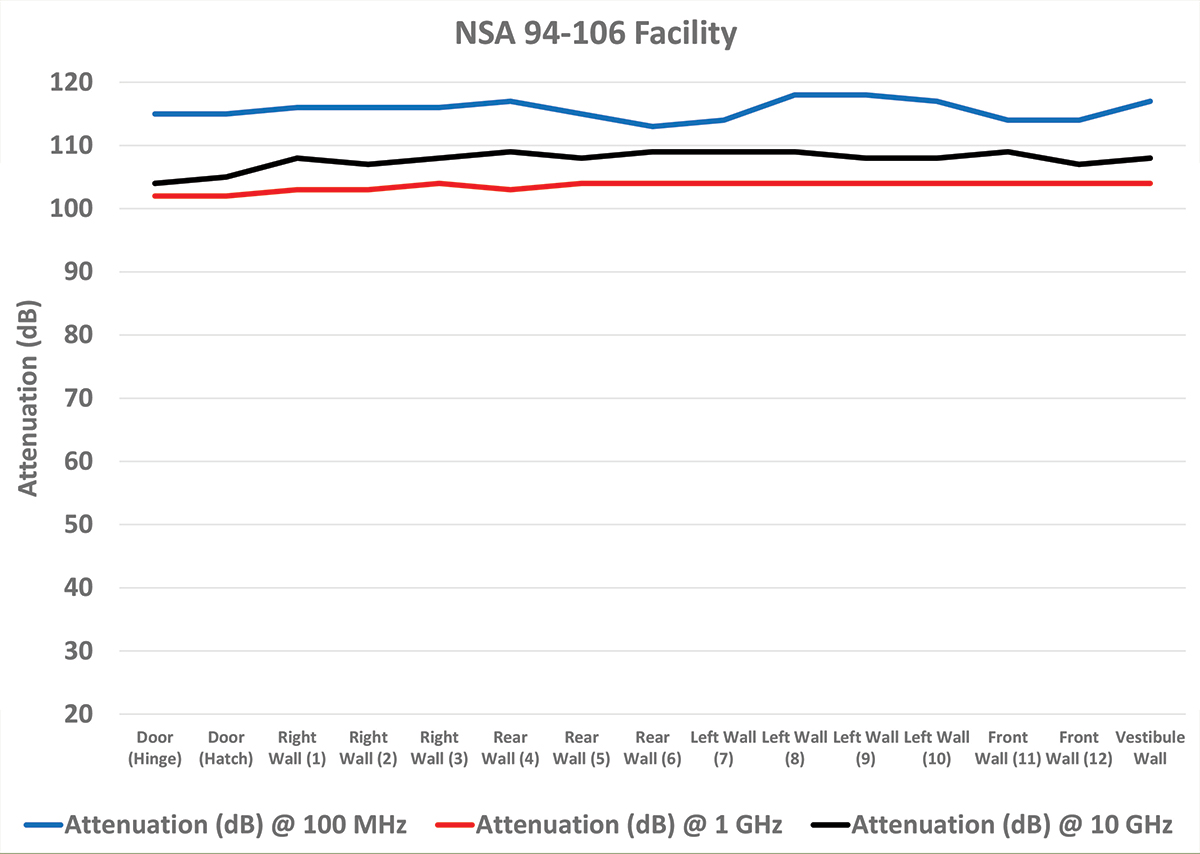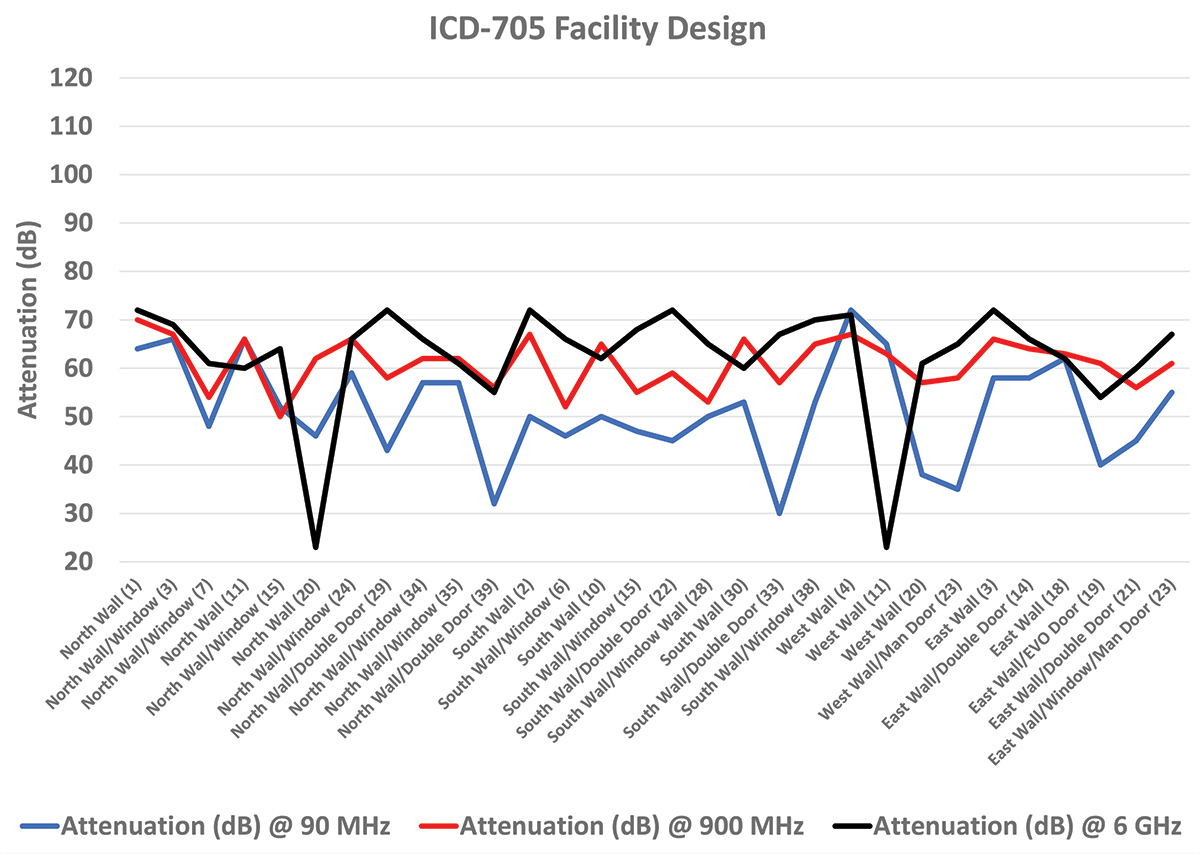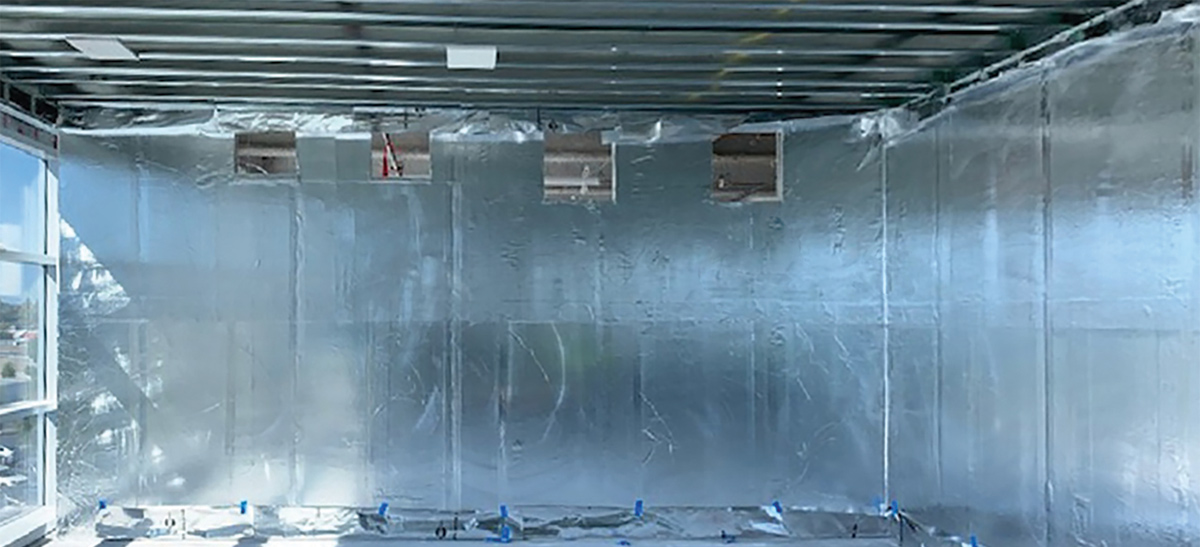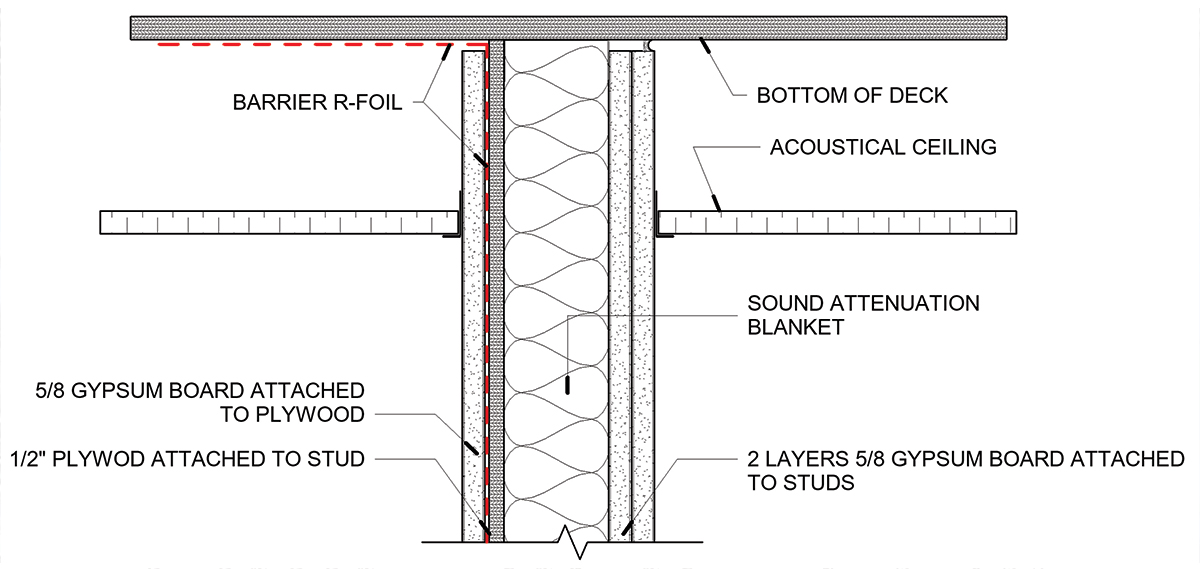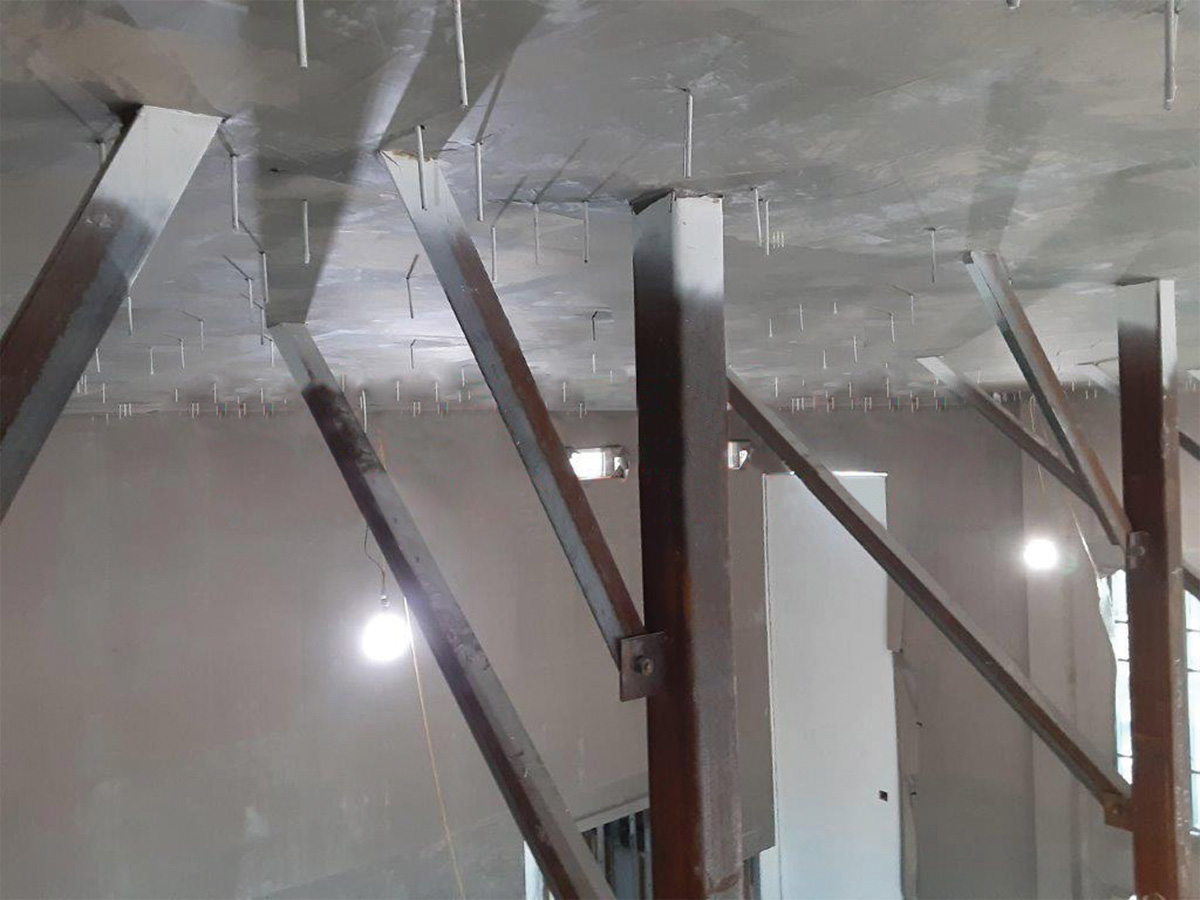n recent years, we’ve noticed a growing confusion in the industry over design and performance requirements for sensitive compartmented information facilities (SCIF). Part 2 of this article is intended to highlight the significant difference in the performance of radiofrequency (RF) shielding between facilities designed per ICS/ICD-705[1] and those intended to meet NSA 94-106[2] performance requirements. We will also highlight some of the design and construction methodologies that lead to significant differences in performance.
Part 2 of this article will highlight some of the methods utilized in ICS/ICD-705 that limit RF shielding performance and some alternate methods that could increase the RF shielding performance. Further, we will discuss other common deviations that often increase project costs without providing any enhanced RF performance. Finally, Part 2 will document the significant differences in potential RF performance utilizing measurement data collected from a facility built per ICS/ICD-705 construction methods and a facility designed to meet NSA 94-106 requirements.
Despite a clear process for design direction and general construction recommendations established in ICS/ICD-705, many project documents deviate from the typical ICS/ICD-705 direction. Those deviations can range from specifying alternate shielding materials to utilizing alternate construction methods to establishing RF performance requirements not supported by the project’s design. These deviations often have a variety of adverse effects from increased project costs to designs that do not support the shielding requirements. This puts all involved, including the facility owners, facility designers, and general contractors, in the challenging position of having to work through the disconnects between design and specified performance, often during the construction phase of a project.
Previously, we noted several reasons why design recommendations in ICS/ICD-705 will not achieve NSA performance requirements. Some of these reasons include the manufacturer’s data for the shielding foil material typically specified for SCIF applications clearly demonstrating that the material will not achieve NSA 94-106 shielding performance requirements. We also identified that the recommended construction for walls in ICS/ICD-705 results in substantial perforation of the shielding material, which will degrade performance. Other factors include the typical ICS/ICD-705 design recommendations that do not require shielding on the ceiling or floor and do not call for use of other elements critical to achieving high levels of RF shielding performance, including filters, waveguides for mechanicals, and RF shielded doors.
Based on their assessment, the CTTA may provide recommendations or require the shielding of floors and ceilings and request the inclusion of filters, treated penetrations, and RF doors. But this does not mean the design will meet NSA 94-106 performance without substantial changes to the general design recommendations provided in ICS/ICD-705.
To highlight this discrepancy, data is provided from two different SCIF facilities. The first facility, with performance data provided in Figure 1, was designed and constructed in strict accordance with NSA 94-106. Therefore, this facility was designed and constructed using shielding materials that meet all the magnetic field, electric field, plane wave, and microwave performance requirements identified in NSA 94-106, which include 100 dB of attenuation at 10 GHz. This requires a six-sided RF shielded enclosure with properly treated penetrations, electrical filters, and a high-performance shielded door.
Since the SCIF facility performance requirements identified frequencies that did not coincide with NSA 94-106 test frequencies, only the 100 MHz, 1 GHz, and 10 GHz test frequencies of the facility designed to meet NSA 94-106 were provided to achieve as relevant a comparison as possible. There is clearly a significant difference in the performance, with average differences of 55 dB or more and peak differences of up to 80 dB. The ICS/ICD-705 Wall A calls for the shielding layer to be sandwiched between two layers of drywall, but the finish layer of drywall had not been installed at the time that these measurements were recorded and the shielding performance would likely decrease further once the drywall is added.
Another factor limiting the RF shielding performance is the primary recommended shielding material. An example of the material often used in SCIF designs is shown in Figure 3. The most frequently recommended shielding material does meet the RF shielding attenuation requirements of NSA 94-106, according to the manufacturer’s data. But the manufacturer’s data is based on a small sample under ideal test conditions, tested on an RF shielded enclosure, and performs optimally at greater than 100 dB from 100 MHz to approximately 1.5 GHz. Above 1.5 GHz, the performance rolls off according to the manufacturer’s data. The performance below 100 MHz appears to roll off as well, and the attenuation will certainly decrease substantially for magnetic (H-field) fields as the frequency decreases.
It is also common to see many issues overlooked in designs that are critical to RF performance, resulting in incremental degradation of RF shielding performance. Common issues include not identifying all items that require filtering. Whether it is used for power, communication, data, or building management systems, a component than includes or uses conductive cables or wires needs to be filtered to maximize the RF performance of a shielding system.
There are multiple examples of a facility filtering all power sources but choosing not to filter all data lines because the data is entering through the floor, which is slab on grade. However, it does not matter the location from where that cable or wire is entering. If it is conductive, it has the ability to carry signals and radiate similar to an antenna. Similarly, critical or protected signals are at risk of coupling to those cables or wires and leaving the secured space. In some cases, this lack of protection may be a concern over costs associated with data filters or communication filters. However, a cost-effective solution may be to use fiber-optics in the secure space that can penetrate the shielding through an inexpensive RF waveguide or series of RF waveguides.
Other common design issues include allowing untreated mechanicals and plumbing not specific to the SCIF to penetrate and pass through the SCIF RF shielding. This simply creates additional points where RF signals can leak into or out of the SCIF. Again, if the purpose is to maximize RF shielding performance, then any penetration into or out of the shielded space must be properly treated. To avoid potential RF performance issues, it is recommended that only items being utilized in the RF shielded space of a SCIF pass through the RF barrier and that any other items supplying other areas of the facility be routed outside the shielded space. Of course, there are exceptions, but those should be evaluated individually based on an assortment of factors including the cost and the impact on RF performance.
Other common construction challenges when building a SCIF include shielding at the ceiling, RF-shielded doors, and treatment of penetrations when specific RF performance requirements have been identified as part of the design requirements. Many SCIF designs may require that the wall foil turns onto and overlaps the ceiling around the perimeter of the SCIF when the ceiling is a metal pan deck. However, RF performance will be limited by the existing penetrations through the metal deck.
Additionally, projects may identify that a shielding material must be applied to a ceiling. In most cases, the ceiling is also used to support electrical and mechanical systems and components such as plumbing and HVAC. This is often accomplished using threaded rods or angles that are attached through the ceiling. An example is shown in Figure 5.
There may also be untreated penetrations through the walls. If the penetrations are made of a conductive material, such as with conduit, plumbing, and HVAC ducts, it may be recommended that the shielding be bonded to the penetration in an effort to maximize the shielding performance. However, this recommendation does not represent a best practice for RF shielding and will likely reduce the overall shielding performance. Further, these penetrations may have construction debris or paint and may limit electrical conductivity if not cleaned properly. Lastly, the penetration may not be conductive, made of either PVC or some other nonconductive material. These penetrations represent additional areas that could significantly reduce the RF shielding performance. An example is shown in Figure 6.
Under NSA 94-106, these issues are addressed by either creating a vestibule or an enlarged door jamb to accommodate an acoustic door with the required security locks and a separate RF door to meet the RF performance requirements. Most SCIF designs do not include this type of design for doors, creating a significant and expensive construction issue when SCIF project documents identify NSA 94-106 or some other elevated level RF performance (>60 dB at 10 GHz).
Finally, it is not uncommon to discover that a project’s design will not meet the RF performance requirements. This puts the project team in the precarious position of having to determine where to compromise between design and project performance requirements while absorbing unexpected and potentially substantial additional costs.
To mitigate these issues, we recommend that SCIF design teams review the actual requirements with the CTTA before a project specification or request for quotation is finalized. It’s also a good idea to include an RF shielding consultant on the design team to assist in coordinating the RF shielding design and to ensure that the finished structure meets the performance requirements.
- ICS/ICD-705, “Technical Specification for Construction and Management of Sensitive Compartmented Information Facilities.” Available at https://www.dni.gov/files/Governance/IC-Tech-Specs-for-Const-and-Mgmt-of-SCIFs-v15.pdf.
- NSA 94-106 (not available for public reference).
- “SCIF and Radio Frequency Secured Facility Design: An RF Shielding Design Guide to Navigating ICS/ICD 705 and NSA 94-106 Requirements,” In Compliance Magazine, June 2021. Available at https://incompliancemag.com/article/scif-and-radio-frequency-secured-facility-design.
- TEMPEST is a U.S. National Security Agency specification and a NATO certification used in reference to secure facilities.
- IEEE 299, “IEEE Standard Method for Measuring the Effectiveness of Electromagnetic Shielding Enclosures.”

